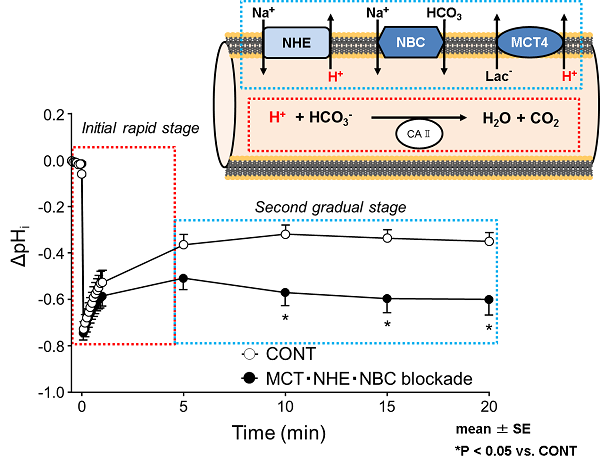Cell pH regulation revealed

Most physiological processes are pH-sensitive, and pH within individual cells in skeletal muscles (pHi) must be carefully regulated to maintain normal cellular functioning. During intensive exercise, and also in certain diseases, levels of a cationic form of hydrogen (H+) rise rapidly within cells, causing pHi levels to plummet and become more acidic. There are three membrane transporters known to be involved in regulating pHi, but their precise individual roles are unclear.
Yutaka Kano and co-workers at the University of Electro-Communications, Tokyo, together with scientists across Japan and the US, conducted experiments using in vivo bioimaging models to verify the roles of these transporters in pHi regulation.
The team tested the effects of an injection of H+ into single muscle fibers in rats. They blocked each transporter involved in pHi regulation - namely, lactate/H+ cotransporter (MCT), Na+/ H+ exchange transporter (NHE) and Na+ / HCO3 cotransporter (NBC) - one at a time and then all together. They compared their results with a control group with normal transporter functioning.
Their results showed that two stages exist in pHi recovery; an initial rapid stage followed by a second, more gradual recovery stage. Kano's team discovered that the three transporters were not involved in the rapid stage. While individual transporter inhibition did not impact on pHi recovery, blocking all three transporters prevented the second stage (gradual recovery) from occurring.
The study also revealed that the pH of surrounding fibers changed following H+ injection, suggesting that they take up excess H+ to alleviate stress in affected cells.
More information: Yoshinori Tanaka et al. pH buffering of single rat skeletal muscle fibers in the in vivo environment, American Journal of Physiology - Regulatory, Integrative and Comparative Physiology (2016). DOI: 10.1152/ajpregu.00501.2015



















